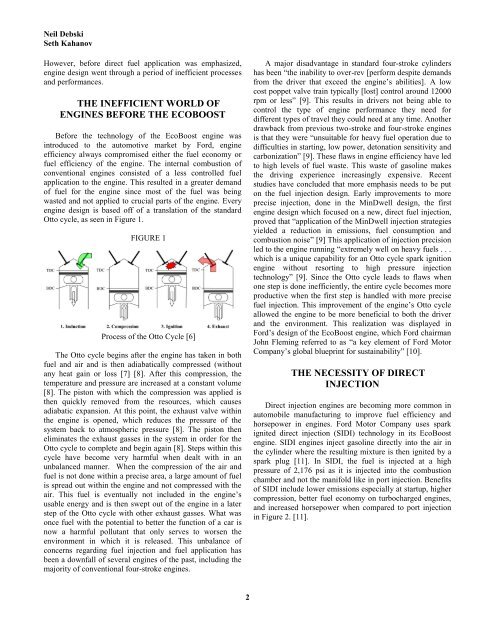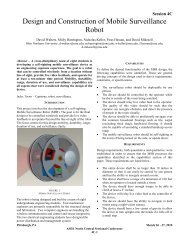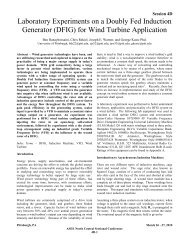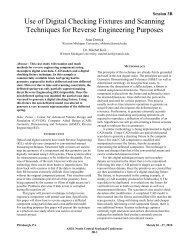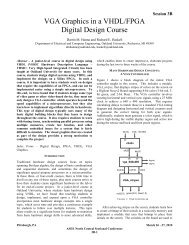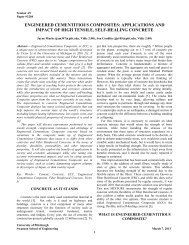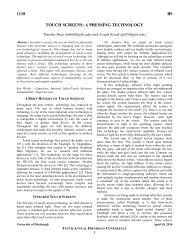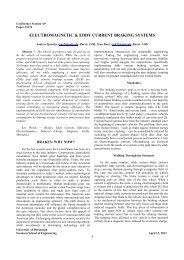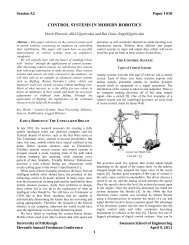THE ECOBOOST ENGINE: COMBINING VARIABLE VALVE TIMING ...
THE ECOBOOST ENGINE: COMBINING VARIABLE VALVE TIMING ...
THE ECOBOOST ENGINE: COMBINING VARIABLE VALVE TIMING ...
You also want an ePaper? Increase the reach of your titles
YUMPU automatically turns print PDFs into web optimized ePapers that Google loves.
Neil Debski<br />
Seth Kahanov<br />
However, before direct fuel application was emphasized,<br />
engine design went through a period of inefficient processes<br />
and performances.<br />
<strong>THE</strong> INEFFICIENT WORLD OF<br />
<strong>ENGINE</strong>S BEFORE <strong>THE</strong> <strong>ECOBOOST</strong><br />
Before the technology of the EcoBoost engine was<br />
introduced to the automotive market by Ford, engine<br />
efficiency always compromised either the fuel economy or<br />
fuel efficiency of the engine. The internal combustion of<br />
conventional engines consisted of a less controlled fuel<br />
application to the engine. This resulted in a greater demand<br />
of fuel for the engine since most of the fuel was being<br />
wasted and not applied to crucial parts of the engine. Every<br />
engine design is based off of a translation of the standard<br />
Otto cycle, as seen in Figure 1.<br />
FIGURE 1<br />
Process of the Otto Cycle [6]<br />
The Otto cycle begins after the engine has taken in both<br />
fuel and air and is then adiabatically compressed (without<br />
any heat gain or loss [7] [8]. After this compression, the<br />
temperature and pressure are increased at a constant volume<br />
[8]. The piston with which the compression was applied is<br />
then quickly removed from the resources, which causes<br />
adiabatic expansion. At this point, the exhaust valve within<br />
the engine is opened, which reduces the pressure of the<br />
system back to atmospheric pressure [8]. The piston then<br />
eliminates the exhaust gasses in the system in order for the<br />
Otto cycle to complete and begin again [8]. Steps within this<br />
cycle have become very harmful when dealt with in an<br />
unbalanced manner. When the compression of the air and<br />
fuel is not done within a precise area, a large amount of fuel<br />
is spread out within the engine and not compressed with the<br />
air. This fuel is eventually not included in the engine’s<br />
usable energy and is then swept out of the engine in a later<br />
step of the Otto cycle with other exhaust gasses. What was<br />
once fuel with the potential to better the function of a car is<br />
now a harmful pollutant that only serves to worsen the<br />
environment in which it is released. This unbalance of<br />
concerns regarding fuel injection and fuel application has<br />
been a downfall of several engines of the past, including the<br />
majority of conventional four-stroke engines.<br />
A major disadvantage in standard four-stroke cylinders<br />
has been “the inability to over-rev [perform despite demands<br />
from the driver that exceed the engine’s abilities]. A low<br />
cost poppet valve train typically [lost] control around 12000<br />
rpm or less” [9]. This results in drivers not being able to<br />
control the type of engine performance they need for<br />
different types of travel they could need at any time. Another<br />
drawback from previous two-stroke and four-stroke engines<br />
is that they were “unsuitable for heavy fuel operation due to<br />
difficulties in starting, low power, detonation sensitivity and<br />
carbonization” [9]. These flaws in engine efficiency have led<br />
to high levels of fuel waste. This waste of gasoline makes<br />
the driving experience increasingly expensive. Recent<br />
studies have concluded that more emphasis needs to be put<br />
on the fuel injection design. Early improvements to more<br />
precise injection, done in the MinDwell design, the first<br />
engine design which focused on a new, direct fuel injection,<br />
proved that “application of the MinDwell injection strategies<br />
yielded a reduction in emissions, fuel consumption and<br />
combustion noise” [9] This application of injection precision<br />
led to the engine running “extremely well on heavy fuels . . .<br />
which is a unique capability for an Otto cycle spark ignition<br />
engine without resorting to high pressure injection<br />
technology” [9]. Since the Otto cycle leads to flaws when<br />
one step is done inefficiently, the entire cycle becomes more<br />
productive when the first step is handled with more precise<br />
fuel injection. This improvement of the engine’s Otto cycle<br />
allowed the engine to be more beneficial to both the driver<br />
and the environment. This realization was displayed in<br />
Ford’s design of the EcoBoost engine, which Ford chairman<br />
John Fleming referred to as “a key element of Ford Motor<br />
Company’s global blueprint for sustainability” [10].<br />
<strong>THE</strong> NECESSITY OF DIRECT<br />
INJECTION<br />
Direct injection engines are becoming more common in<br />
automobile manufacturing to improve fuel efficiency and<br />
horsepower in engines. Ford Motor Company uses spark<br />
ignited direct injection (SIDI) technology in its EcoBoost<br />
engine. SIDI engines inject gasoline directly into the air in<br />
the cylinder where the resulting mixture is then ignited by a<br />
spark plug [11]. In SIDI, the fuel is injected at a high<br />
pressure of 2,176 psi as it is injected into the combustion<br />
chamber and not the manifold like in port injection. Benefits<br />
of SIDI include lower emissions especially at startup, higher<br />
compression, better fuel economy on turbocharged engines,<br />
and increased horsepower when compared to port injection<br />
in Figure 2. [11].<br />
2


